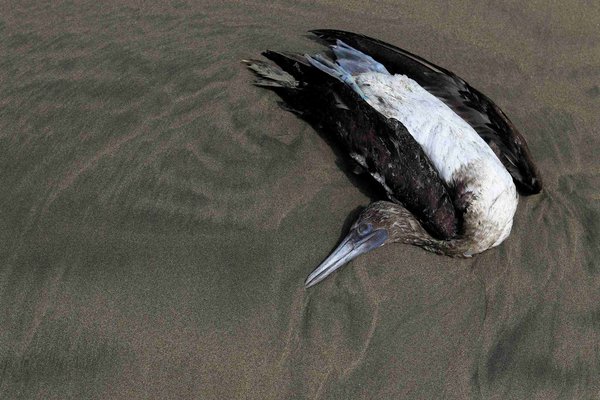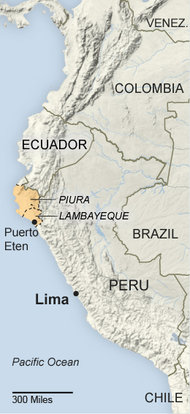
(above) A blue-footed booby found Sunday on a beach south of Lima. Officials say seabirds may be starving, and dolphins may have a virus. Mariana Bazo/Reuters
Dead Dolphins and Birds Are Causing Alarm in Peru
May 7, 2012 - New York Times
By DAVID JOLLY and ANDREA ZARATE
Late last year, fishermen began finding dead dolphins, hundreds of them, washed up on Peru's northern coast. Now, seabirds have begun dying, too, and the government has yet to conclusively pinpoint a cause.
 Officials insist that the two die-offs are unrelated. The dolphins are succumbing to a virus, they suggest, and the seabirds are dying of starvation because anchovies are in short supply.
Officials insist that the two die-offs are unrelated. The dolphins are succumbing to a virus, they suggest, and the seabirds are dying of starvation because anchovies are in short supply.
But even three months after officials began testing the dolphins, the government has not released definitive results, and there is growing suspicion among the public and scientists that there might be more to the story. Some argue that offshore oil exploration could be disturbing wildlife, for example, and others fear that biotoxins or pesticides might be working their way up the food chain.
At least 877 dolphins and more than 1,500 birds, most of them brown pelicans and boobies, have died since the government began tracking the deaths in February, the Environment Ministry said last week. The dolphins, many of which appeared to have decomposed in the ocean before washing ashore, were found in the Piura and Lambayeque regions, not far from the border with Ecuador.
The seabirds, which seem mostly to have died onshore, have been found from Lambayeque to Lima. "Never in my 40 years as a fisherman have I seen anything like this," said Francisco Ñiquen Rentería, the president of the Association of Artisanal Fishermen in Puerto Eten, in the Lambayeque region. "Sometimes in the past, you'd randomly see a dead dolphin or a pelican, but this, what's happening now, is really alarming."
"It is odd indeed," Gabriel Quijandría, the deputy environment minister, acknowledged in an e-mail. "But they are not related."
The federal Ocean Institute has said that the most likely culprit in the dolphin deaths is the morbillivirus, from a family of viruses linked to previous mass deaths of marine mammals, Mr. Quijandría said, though officials in recent days have sounded less certain.
For the seabirds, he wrote, the "most plausible hypothesis so far" from the National Agricultural Health Service is that they are dying from a lack of food, mainly anchoveta (Engraulis ringens), a Peruvian anchovy, as a result of the sudden heating of coastal waters.
The Environment Ministry said the dolphin deaths had no link to fisheries, red tides or other biotoxins, bacteria, heavy metals or pesticides. It said it had also ruled out any connection to offshore seismic testing by companies to locate oil and gas deposits under the seabed.
Still, fishermen, environmentalists and others suspect that government officials are not being completely candid.
The discovery of dead animals on beaches near Lima, the capital, in recent days has complicated matters. Over the weekend, the Health Ministry issued an alert advising people to avoid the waters around Lima and to the north, "until we know the cause of the recent deaths of marine species."
It advised people not to eat raw seafood, an ingredient of the national favorite ceviche, and recommended that people disposing of dead marine animals wear gloves and masks. The warning sowed confusion, given earlier government statements indicating that the seabirds were probably starving rather than falling ill from some disease.
The Peruvian coast, nourished by the cold Humboldt Current, is one of the richest marine habitats on earth. Flowing north from Antarctic waters, the current lifts nutrients from the ocean depths into zones nearer the surface.
So plentiful are the plankton in these waters that the area has the world's largest fishery, focused on the anchoveta. The fish is an important component of the diets of the dolphins, seabirds and other predators.
The Environment Ministry says that data from the South American institute for the study of the effect of El Niño show that coastal water temperatures have been above average in recent months. The anchoveta prefer the colder water, and if they descend below a depth of six or seven feet the pelicans cannot reach them.
That explanation doesn't satisfy Juan Sernaque Juárez, 34, a fisherman from the northern town of Tumbes, who attributes the die-offs to seismic testing by oil and gas companies. He said that he and some of his neighbors had gone on strike a few months ago to protest the testing, which they believe was killing dolphins, birds and sea lions. "But it didn't work," he said, "and now we're the ones mostly suffering the results."
In offshore seismic testing, ships tow arrays of air guns that release high-pressure air under water, producing sound waves that can be analyzed to locate oil and gas deposits deep under the ocean floor.
But Mr. Quijandría, the deputy environment minister, said that the dolphins had not shown signs of damage to internal organs, ear structures or bones that would be consistent with injuries from underwater explosions.
One of the exploration companies, BPZ Energy, released a statement saying its operations were far north of the area where the dolphins had washed up and that the die-offs began before it began its recent surveys.
Mr. Ñiquen Rentería, 57, from Puerto Eten, who fishes for small sharks and flatfish, contends that the government is underestimating the extent of the dolphin deaths. He said by telephone that he had seen at least 3,000 dead dolphins on the beach since November and that they were still dying, although no longer in such large numbers.
But Mr. Quijandría said there was no evidence that that many dolphins had died.
The Peruvian news media have raised the possibility that pesticides could be poisoning the animals. Pedro Alva, president of the Regional Development Institute of the Lambayeque region, suggested that raw sewage or another effluent could be the culprit.
"It's unbearable to walk around those areas," Mr. Alva said of the rapidly growing towns along the coast. "They dump both their industrial and residential wastes into the ocean without control, without consideration."
Sophie Bertrand, a marine ecologist at the Research Institute for Development in France who is leading a research project on seabirds and sea lions in Peru, said that if there was a common factor linking the die-offs, it would probably be found in the anchoveta, eaten by all of the species concerned.
Even though Peruvian investigators appear to have excluded biotoxins as a possible agent, she wrote in an e-mail, "there are many and it may be difficult to test for all of them."
David Jolly reported from Paris, and Andrea Zarate from Lima, Peru.